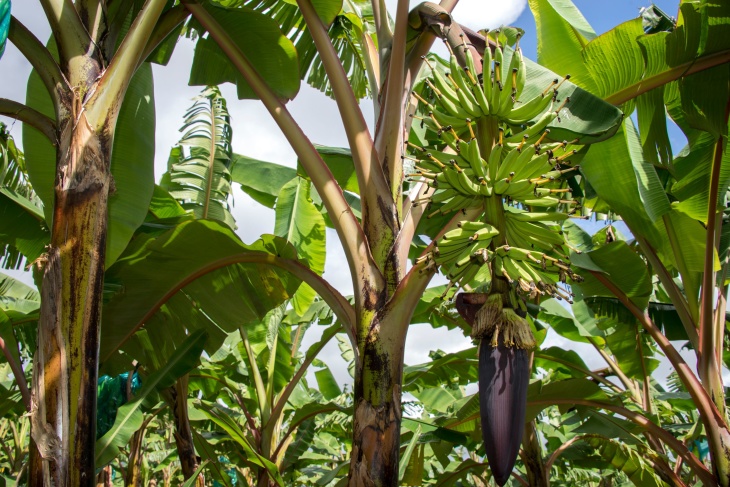
Our news is free on LAist. To make sure you get our coverage: Sign up for our daily newsletters. To support our non-profit public service journalism: Donate Now.
It's a law of a journalist's inbox that we get wild pitches whenever some sort of big news thing happens.
And it was last October, when the Silverado Fire was tearing through the bone-dry hills of Irvine, that I got a curious note from a reputable university. A professor, it said, had an idea to use a certain tropical fruit to help fight fires like the one we were watching on TV.
"Bananas!" was both my immediate reaction and the fruit they were talking about.
The professor was suggesting planting waves of emerald-green banana plants on Southern California's parched hills in an effort to help protect communities from wildfires.
Given how bad the 2020 fire season was, and how desperate we are for solutions to help us cope with what we've wrought, I thought it was worth it to hear him out.
HILLSIDE DEVELOPMENTS
I met up with Barath Ragavan, a rare fruit enthusiast and professor of engineering at USC, in a cul de sac deep inside a luxury housing development in the Irvine hills, the Pacific ocean far off in the distance.
"I chose this specific neighborhood in Irvine as a recent example of a very new development that's been built up into the hills, where the hills are very dry year round and high fire risk," he said.
The Orchard Hills community looks just like every other housing development with home names like Vivo, Terra, and Fresco, that've been built between Los Angeles and San Diego over the past several decades.
Around it were hills charred by the Silverado Fire.
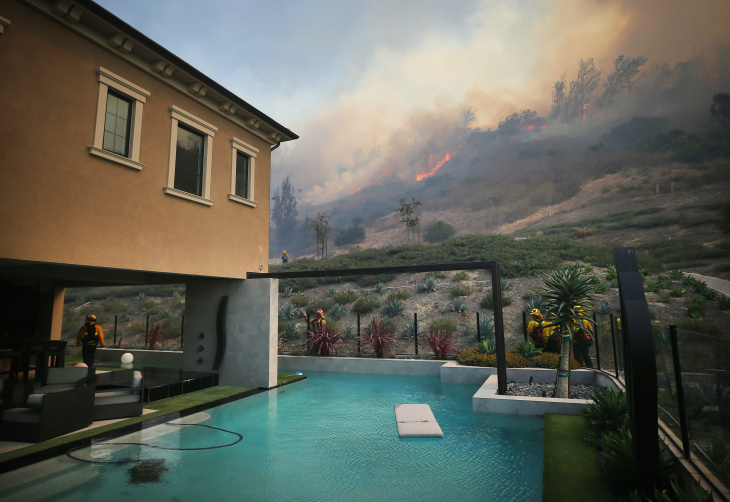
Blackened hills behind developments are a surprisingly familiar scene to anyone who watches coverage of fires here in California.
As populations have grown we've gobbled up more and more undeveloped space for hillside homes, pushing the boundary of the wildland urban interface deeper into wildland, into habitats that burned even before we put homes there. It's no surprise that they regularly catch on fire.
The state now sees annual losses in the billions due to wildfires, and an estimated two million homes across the state are at risk. That risk is expected to triple in some areas in the coming decades as our climate becomes even more conducive to burning.
"The lines have already been drawn in terms of where the sort of wildland urban boundary is. So now our question is, how do we defend that boundary?" asked Ragavan.
That's where his bananas come in.
A MOAT OF BANANAS
"What I would envision doing, all the way from literally the boundary of this house up to the ridge that's above us ... I would've envisioned a banana orchard with a ground cover underneath it that was non flammable," he said.
In the Silverado fire, he says, hundreds of yards of banana plants could have provided valuable protection.
"We would've seen the fire come over the ridge ... It would've come up to the edge of our banana planting. And probably the first row of bananas would've been singed, but they wouldn't have caught fire, because they don't catch fire easily."
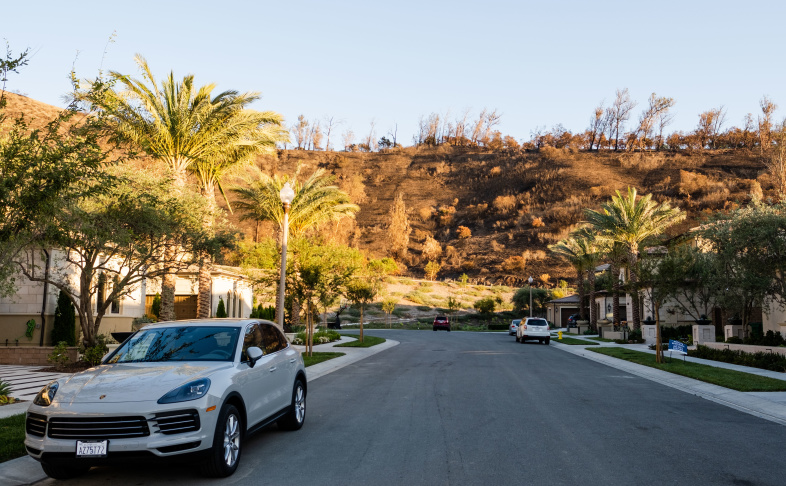
That's the crux of his proposal. The fact that well-irrigated banana plants are quite moist, and thus more resistant to fire than dry grasses and shrubs.
Think about when you use banana leaves to cook, say, fish, over a flame. They protect the delicate meat on the inside from the harsh heat on the outside. And because of the moisture content of the leaves, they mostly steam rather than burn (until you leave them on long enough, and they dry out and catch on fire).
If we replaced those fast-burning grasses with wet, slower-burning banana plants, even if they did eventually combust, they could buy firefighters more time to react and community members more time to evacuate. Or, maybe in some instances, the plantings would be deep enough that they could stop fires altogether.
The planting could also potentially lessen the number of flying embers landing on houses, an important consideration given that they're one of the main ways homes catch on fire.
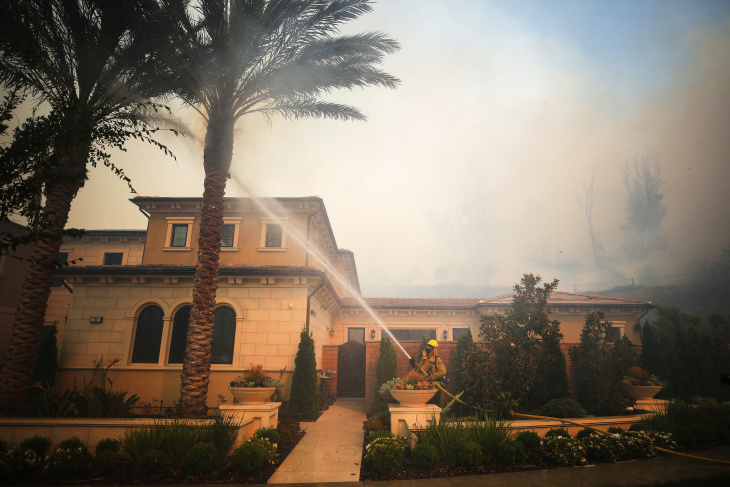
VETTING THE IDEA
Real world experiments pitting a dense planting of bananas against strong, wind-driven flames have yet to be performed.
So I reached out to a bunch of fire experts to hear their thoughts about the unconventional solution to some of our fast-moving fire woes. And ended up spending a decent amount of time convincing people I was serious.
Eventually, my search took me to Australia, where banana farms and fire are commonplace.
"The idea of irrigating and planting non-flammable plants like bananas is a great idea," said David Bowman, a professor of fire science and pyrogeography at the University of Tasmania.
He explained that while he's never seen bananas used to stop fire, the core concept that Ragavan is getting at isn't new. It's what's known as a green firebreak, in which a wide planting of wet vegetation is used to buffer against walls of flames.
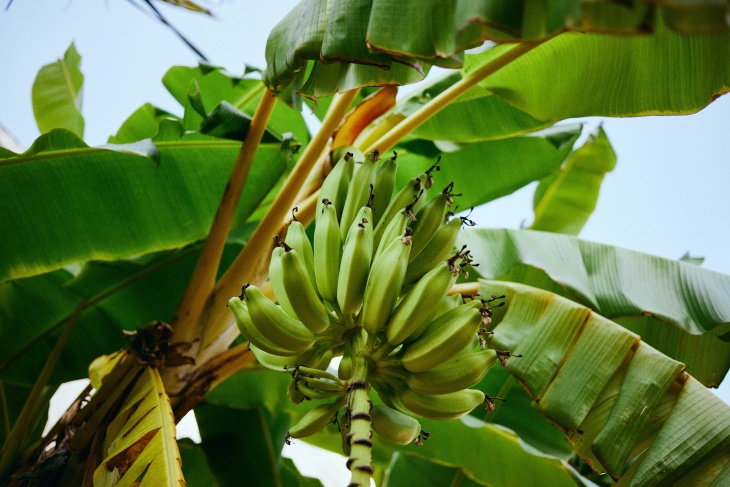
"It's kind of a stupid idea to have the mix of wild nature with urbanization. That's just like mixing oil and water. Unless you've got specially designed houses that can stand being burnt," said Bowman.
"But most people don't want to live in those houses. They're very expensive. And so the better way of doing it is modifying the landscape, but that means that you have to sign on to a modified landscape."

Banana plants are one potential option, but deep plantings of other wet plants, like succulents, may work better, depending on the landscape and water availability. Anything that resists immediately bursting into flames and casting waves of embers, as our dry grasses do, has potential.
"This is a technique that's been deployed on every vegetated continent and a wide range of different countries around the world, but it's been quite surprising to us how little it's been tested," said Tim Curran, senior lecturer in ecology at Lincoln University in New Zealand.
"There have been some instances where it's been tested and China's one of those. China is definitely the world leader in implementation."
The country reportedly had 89 million acres of green fire breaks planted as of 2003, according to Curran. He and his colleagues at the University are running flammability tests on plants to figure out which may be effective for use as green firebreaks in their local climate.
"One of the big things with green firebreaks is the potential not just to be a device to help you reduce fire spread, but potentially also to conserve biodiversity," said Curran.
"So if you can establish green fire breaks from native species that are native to the landscape, where you are, you can actually potentially have improved biodiversity outcomes as well. Particularly if you're dealing with a landscape that's already been heavily modified."
Cal Fire has a few recommendations for less flammable landscaping people can plant around their homes. But nothing meant to be used on the scale that Ragavan's talking about.
CAL FIRE'S THOUGHTS
When asked whether they'd seen bananas used as a sort of defense against flames, Cal Fire said no. However, well maintained fruit orchards do change fire behavior.
"Avocado groves typically are very resistant to fires, but when they're not watered or there's an error in the irrigation and some of the trees die, then they become a fire source as opposed to a fire suppressant," said Battalion Chief Jon Heggie.
Above where Ragavan and I were standing in the Orchard Hills development, the Silverado Fire had burned right up and into an avocado orchard. Some trees were charred, while others seemed to be OK.
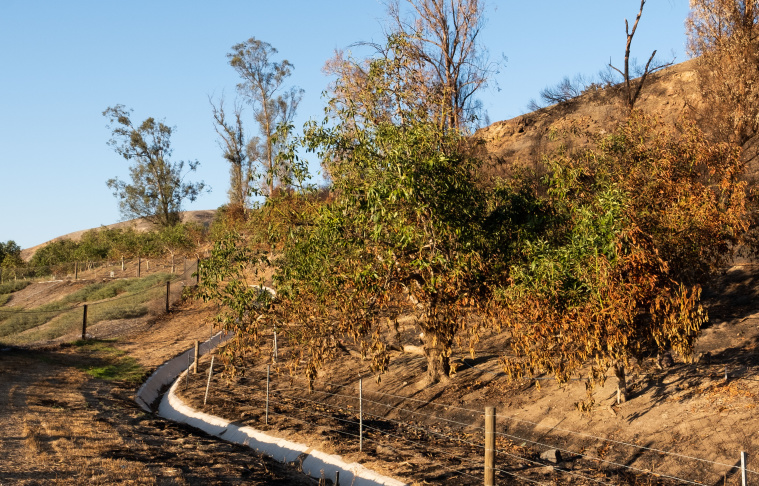
"Maybe it works, maybe it doesn't. But I think we're all open to new ideas in doing things differently since we've seen the fire environment change so much over the past 10 years."
PEELING BACK THE ARGUMENT
Even if bananas do turn out to be exceptionally effective at slowing down and stopping fire, there are a number of obvious challenges we haven't talked about.
- The idea would really only work in areas with no or minimal frost, as bananas are sensitive to cold. Though, that's becoming less of a concern as the climate continues to warm.
- The plants are extremely thirsty and water is a perennial worry here. Ragavan proposes utilizing recycled water, which is already widely used to irrigate urban landscapes, including at the Orchard Hills development we went to.
- It would likely work best in places with well-defined wildland urban boundaries. Think the developments in the hills around the San Fernando Valley and in Orange County.
- Long term upkeep is also a concern. Ragavan envisions establishing some sort of market for the locally grown bananas, which he believes could help subsidize costs.
FIRES ARE SO, SO BAD NOW
The biggest hurdle?
We're living through the worst fires on record, year after year. And they might be too much, even for wet bananas.
Bowman recalled back in 2019, seeing hot and dry winds push along fire so violently, and dessicate plants so effectively, that a banana plantation went up in flames in Northern New South Wales.
"That was a real light bulb moment for me. To see a banana plantation destroyed. Not a strip, but a plantation. A working farm. Torched. By a fire storm. It just tells you what nature has got up its sleeve if it really wants to hammer humans. Nature can dish out a lot of pain with these extreme fire events," he said.
"Now the interesting thing about that banana plantation is that it would've been absorbing a lot of the energy out of the fire. And it would've been changing the fire behavior. That hasn't been documented, but I'm certain if you looked on the other side of the banana plantation in Northern New South wales, it would've had some effect."
ANOTHER TOOL TO CONSIDER
Managing fires in California is only going to get more and more complicated, and it's worth considering what else we can do to adjust. Bananas, or some other green firebreak, could be another tool in the toolbox to consider as we barrel full speed into our bleak fire future.
"We're seeing extreme fires now, four years in a row across the state. Something's going to give. Do people move? ... Do we accept that it's just evacuation season in the fall?" asked Ragavan.
"Bright green bananas on the hillside are going to look far nicer than charred hills."
Ragavan and his colleague, professor Michael Kantar at the University of Hawaii, are working on setting up a test plot to put the idea to work in real life.
He also hopes to develop software that'll allow land managers to easily identify different plant species that may best serve their landscapes, including those that may be fire resistant.
"fruit" - Google News
February 24, 2021 at 09:00PM
https://ift.tt/3so7nTr
A Totally Bananas Idea? Planting Tropical Fruit Trees To Help Fight California Wildfires - LAist
"fruit" - Google News
https://ift.tt/2pWUrc9
https://ift.tt/3aVawBg
Bagikan Berita Ini














0 Response to "A Totally Bananas Idea? Planting Tropical Fruit Trees To Help Fight California Wildfires - LAist"
Post a Comment